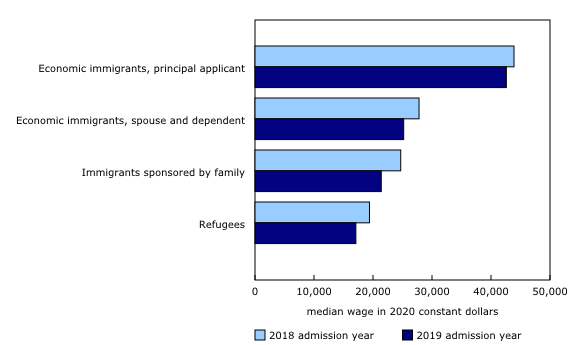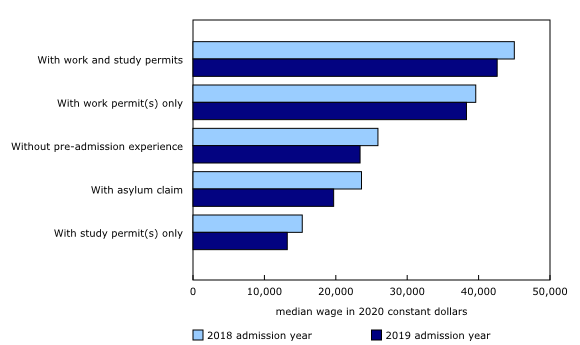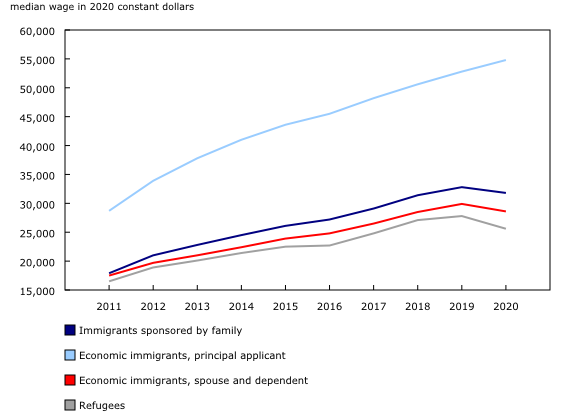The COVID-19 pandemic disrupted the economic integration of many immigrants
Released: 2022-12-05
Immigrants make a critical contribution to Canada's labour force by helping to mitigate the impacts of labour shortages fuelled by low fertility rates and an aging population. From 2016 to 2021, immigrants contributed to four-fifths of labour force growth.
A growing percentage of immigrants have pre-admission work and study experience in Canada, which contributes to better integration into the labour market and improvement in economic outcomes among the immigrant population. From 2015 to 2019, the gap narrowed between recent immigrants who have lived in Canada for 10 years or less and the Canadian-born population in terms of employment rate and earnings.
However, economic lockdowns in response to the COVID-19 pandemic disproportionately affected the immigrant population and disrupted their finances more than the Canadian-born population. When the pandemic first hit, recent immigrants, especially immigrant women, were more likely than their Canadian-born counterparts to transition out of employment. A higher share of immigrants work in low-wage and short-tenured jobs and in certain sectors such as food and accommodation services, all of which were more strongly affected by pandemic lockdowns. As a result, immigrants were more likely to apply for the Canadian Emergency Response Benefit in 2020.
Using the 2021 Longitudinal Immigration Database (IMDB), which provides data up to the 2020 taxation year, this article outlines how the first year of the pandemic slowed the socioeconomic progress that immigrants have made over the past decade. The IMDB is the result of a collaboration between Statistics Canada, Immigration, Refugees and Citizenship Canada, and the provinces.
Median entry wages drop for the first time in 10 years, but total income increases from 2019
The pandemic triggered a labour market contraction that negatively affected many Canadians, but new immigrants who were admitted during 2019 were particularly vulnerable. In tax year 2020, the median entry wage of immigrants admitted in 2019 was $30,000, which was 6.5% lower than the median entry wage of the 2018 admission cohort in tax year 2019 ($32,100). This marks the first year the median entry wage, reported one year after admission, declined in the past decade. This decrease was observed in all provinces and territories except Manitoba and Prince Edward Island.
The overall Canadian population experienced a slight increase (+0.8%) of their median wage, going from $39,440 in 2019 to $39,760 in 2020. This difference in trends between the total population and new immigrants widened the wage gap between them.
Immigrant women admitted in 2019 experienced greater challenges than both immigrant men counterparts and Canadian women. The median entry wage of immigrant women fell by 11.1% from $26,100 in 2019 to $23,200 in 2020. Immigrant men saw a decline in their median entry wage of 5.2% (from $38,100 to $36,100), while the median wage for Canadian women was virtually unchanged (from $33,840 to $33,830) during the same period. These results are consistent with the findings from recent studies on the gaps in employment by gender and by immigration status.
Economic principal applicants are admitted based on their skills, professional experience, and an ability to contribute to Canada's economy. Among all immigrants admitted in 2019, economic principal applicants had the highest median entry wage in 2020 ($42,600) and the lowest rate of decrease in median entry wage from 2019 to 2020 (-3.0%). Economic spouses and dependents had the second highest median entry wage in 2020 ($25,200), followed by family-sponsored immigrants ($21,400). The entry wage declined the most for immigrants sponsored by family (-13.4%), followed by refugees (-11.9%).
During the pandemic, the emergency support measures provided by governments more than compensated for the declines of wages and salaries, with lower-income households experiencing the greatest impact.
This pattern is observed to a certain extent in the improvement in median entry total income, which includes the value of government pandemic support measures, among new immigrants one year after admission. Although the median entry wage declined in 2020, the median entry total income of immigrants increased by 9.3%—from $30,100 in 2019 (2018 admission cohort) to $32,900 in 2020 (2019 admission cohort).
Refugees, whose median entry wage was the lowest, had the highest increase in median entry total income (+21.4%) from 2019 to 2020. In comparison, economic principal applicants, who had the highest median entry wage, had a 2.4% increase in median entry total income.
The median total income among all Canadians rose by 6.9% in the same period (from $37,990 to $40,630).
Knowledge of official languages at admission and pre-admission work experience both ease the economic disruption caused by the COVID-19 pandemic
Knowledge of official languages at admission makes it easier for new immigrants to integrate into the Canadian labour market. From 2019 to 2020, immigrants who had knowledge of both English and French were the only group that saw an increase in median entry wage (+0.3%; from $35,600 to $35,700). In contrast, immigrants with no knowledge of official languages experienced a substantial median entry wage decrease of 18.6% (from $15,600 in 2019 to $12,700 in 2020). Those who only knew English or French saw a decline of 6.5% in median entry wage.
Gaining Canadian work experience prior to admission provides immigrants with an opportunity to get accustomed to the Canadian labour market and secure better-quality jobs. It also mitigates wage loss during an economic downturn. Among immigrants with pre-admission experience, those who had a work permit saw the lowest decrease in median entry wage (-3.3%) from 2019 to 2020. The rate of decrease in median entry wage was slightly greater for those who had work and study permits (-5.3%), but their median entry wage in 2020 remained the highest among those with pre-admission experience.
The median entry wage of immigrants with a study permit was $13,200 in 2020, down from $15,300 in 2019. Trending younger than other pre-admission groups, this group earned the lowest median entry wages, likely because they were still pursuing studies and working part-time at the time of admission. In the longer term, the IMDB data showed that earnings of those with a study permit caught up and exceeded those admitted without Canadian study experience.
Immigrants without pre-admission experience saw a larger decline in their median entry wage relative to the previous admission cohort than those who had study or work permits in Canada.
Despite the pandemic, economic principal applicants have higher median wages in 2020 than in 2019
Most immigrants experience a gradual wage increase over time. However, the pandemic has curbed this trend. Overall, the median wages of immigrants admitted in 2010 remained unchanged from 2019 to 2020.
Among immigrants admitted in 2010, all admission categories saw median wage increases over the first nine years following their admission. In 2020, the median wage of economic principal applicants not only remained the highest, but also extended the upward trend with a 3.8% increase from the previous year (from $52,800 to $54,800).
In contrast, immigrants admitted under different admission categories, especially refugees, experienced median wage losses from 2019 to 2020. Year-over-year decreases were seen among family-sponsored immigrants (-3.0%; from $32,800 to $31,800), economic spouse and dependents (-4.3%; from $29,900 to $28,600), and refugees (-7.9%; from $27,800 to $25,600).
The impact of the pandemic on widening wage disparities between economic principal applicants and other admission categories was also visible in more recent admission cohorts.
As the economy began to recover, employment had returned to the pre-pandemic level by the end of 2021. From 2020 to 2021, the employment rates of recent immigrants rebounded faster than for Canadian-born workers. The long-term effects of the pandemic on immigrants' economic outcomes can be assessed in future releases of IMDB data.
A second article that discusses immigrants' mobility during the pandemic is forthcoming.
Note to readers
Definitions and concepts
The Longitudinal Immigration Database (IMDB) is a comprehensive source of data that plays a key role in understanding the economic behaviour of immigrants and non-permanent residents. It is the only annual Canadian dataset that allows users to study the characteristics of immigrants to Canada at time of admission and the economic outcomes and regional mobility of immigrants over a period of more than 35 years.
The IMDB is the result of a partnership between Statistics Canada, Immigration, Refugees and Citizenship Canada (IRCC), and the provinces. The IMDB combines administrative files on immigrant admissions and non-permanent resident permits from IRCC with tax files from the Canada Revenue Agency. IRCC's administrative records contain extensive information on immigrants admitted to Canada since 1952. They also include information on non-permanent residents who have been granted a temporary resident permit since 1980. Tax records for 1982 and subsequent years are available for immigrant taxfilers.
The IMDB links short-term and long-term outcomes to characteristics at admission, such as immigrant admission class, country of origin and knowledge of official languages. The IMDB also provides information on pre-admission experience in Canada and citizenship acquisition since 2005.
For additional information regarding the data coverage and data quality of the IMDB, users should refer to the Longitudinal Immigration Database (IMDB) Technical Report, 2021.
It is to be noted that the IMDB is updated annually. From year to year, there have been changes to data processing. Each yearly update is independent.
This release analyzes income based on the medians of wages (for the population with wages, salaries or commissions income, excluding self-employment income). The median is the income threshold at which a half of the immigrant taxfilers have higher income and the other half have lower. Zero values are not included in the calculation of medians for individuals. All income estimates are expressed in 2020 constant dollars to factor in inflation and enable comparisons across time in real terms.
Median entry wage in this analysis is the median wage reported one year after admission to Canada as a permanent resident.
Median entry total income in this analysis is the median total income reported one year after admission to Canada as a permanent resident.
Economic immigrant admission categories include immigrants who have been selected for their ability to contribute to Canada's economy through their ability to meet labour market needs, to own and manage or to build a business, to make a substantial investment, to create their own employment or to meet specific provincial or territorial labour market needs.
Immigrant-sponsored family categories include immigrants who were sponsored to come to Canada by a family member who is a Canadian citizen or permanent resident.
Refugee categories include immigrants who were granted permanent resident status on the basis of a well-founded fear of returning to their home country. These include government-assisted refugees, privately sponsored refugees, refugees admitted in Canada, and their dependents.
Principal applicant is the person submitting the immigration application and the individual being assessed on admission criteria under each of the admission categories, while their accompanying spouse and dependents are admitted automatically with the principal applicant.
Taxfilers are immigrants who have filed a tax return for a given taxation year.
For a more detailed description of the immigrant admission classes, see the IRCC Glossary.
Source on income of the Canadian population:
Source for Canadian median wage: Custom tabulation from the T1 Family File (4105).
Source for Canadian median total income: Table 11-10-0008-01 Tax filers and dependants with income by total income, sex and age. Median total income has been adjusted for inflation and dollar amounts are expressed in 2020 dollars.
Products
The Longitudinal Immigration Database 2021, including the wages and salary module (1997 to 2021), is now available upon request.
The publication "Longitudinal Immigration Database (IMDB) Technical Report, 2021" is now available as part of the series Analytical Studies: Methods and References (11-633-X).
The data visualization tool "Longitudinal Immigration Database (IMDB) Interactive Application: Economic Outcomes" is now available as part of the series Statistics Canada - Data Visualization Products (71-607-X).
The products are available on the Immigrant and Non-Permanent Resident Statistics portal. The Portal was designed to provide easy and free access to immigrant and non-permanent resident data and publications. Information is organized into broad categories including analytical products, data products, reference materials and interactive applications.
Contact information
For more information, or to enquire about the concepts, methods or data quality of this release, contact us (toll-free 1-800-263-1136; 514-283-8300; infostats@statcan.gc.ca) or Media Relations (statcan.mediahotline-ligneinfomedias.statcan@statcan.gc.ca).
- Date modified:



